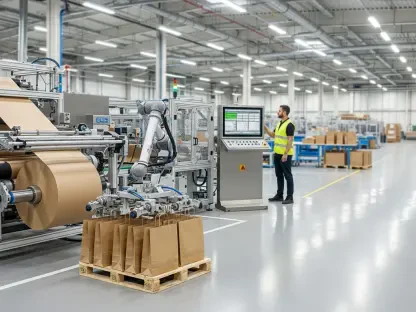The global chemical industry finds itself grappling with an unprecedented structural crisis, primarily fueled by an oversupply of low-cost products flooding the market from dominant players like China. This relentless wave of affordable alternatives has upended traditional market dynamics, slashing revenues and compressing profit margins for companies, particularly in high-cost regions such as Europe and North America. The resulting price wars have left little room for error, pushing industry leaders to rethink long-standing strategies that once prioritized volume over value. Amid this turbulent landscape, operational efficiency emerges as a critical lifeline, offering a path to regain competitiveness and stabilize financial performance. This article delves into the challenges posed by oversupply, exploring actionable strategies for CEOs to streamline operations, boost profitability, and navigate the complexities of a hyper-competitive market while aligning with broader stakeholder expectations.
Unpacking the Oversupply Crisis
The chemical sector is under siege from a structural oversupply, driven largely by China’s commanding position in global production. Holding a substantial share of worldwide output and capital investment, China’s ability to produce at lower costs has saturated markets with affordable products, igniting fierce price competition. This isn’t merely a cyclical hiccup but a deep-rooted shift that challenges the survival of companies in regions with higher operational expenses. The impact is stark: declining revenues and shrinking margins have forced a reevaluation of traditional business models. CEOs must now confront the reality that chasing market share through volume is no longer viable. Instead, the focus must pivot to creating sustainable value by addressing internal inefficiencies and adapting to a landscape where price pressures are a constant. Understanding this oversupply as a long-term issue rather than a fleeting problem is the first step toward crafting strategies that ensure resilience.
Beyond the immediate financial strain, this oversupply crisis reveals systemic vulnerabilities within the industry. Many companies have operated for years with outdated frameworks that fail to counter the aggressive pricing strategies of low-cost producers. The disparity in production costs, especially in energy and labor-intensive regions, exacerbates the challenge, leaving firms in Europe and North America at a disadvantage. This environment demands a fundamental shift in mindset, where survival hinges on agility and cost control rather than expansion. Industry leaders must analyze how global supply chains have evolved and identify where they can carve out competitive edges through smarter operations. By acknowledging the permanence of these market shifts, executives can begin to build frameworks that prioritize long-term stability over short-term gains, setting the stage for a more adaptive approach to the ongoing oversupply dilemma.
Efficiency as a Survival Strategy
Operational efficiency has transitioned from a strategic option to an absolute necessity for chemical companies facing the brunt of oversupply. Far too many organizations are burdened by antiquated processes, disconnected systems, and significant waste in their operations. Research indicates that a staggering portion of maintenance costs—up to one-third in some cases—stems from unnecessary or poorly managed activities. Addressing these inefficiencies presents a clear opportunity to slash expenses and bolster margins, even in a market dominated by low prices. Streamlining workflows, optimizing resource allocation, and eliminating redundant practices can yield immediate financial relief. This approach not only helps companies weather the current storm but also positions them to compete more effectively against lower-cost rivals by focusing on internal improvements rather than external market battles.
Moreover, the pursuit of efficiency uncovers hidden value within existing operations, offering a buffer against relentless pricing pressures. By scrutinizing every aspect of the production cycle, from raw material usage to equipment maintenance, companies can identify areas where costs can be trimmed without compromising quality. For instance, reducing downtime through better scheduling or predictive maintenance can significantly enhance output without additional capital investment. This focus on operational excellence also fosters a culture of continuous improvement, encouraging employees at all levels to contribute ideas for cost savings and process enhancements. As market conditions remain challenging, embedding efficiency into the core of business practices becomes a critical differentiator, enabling firms to maintain profitability while competitors struggle with bloated cost structures. The message is clear: efficiency is the cornerstone of survival in this oversupplied landscape.
Boosting Financial Health Through EBITDA
A critical priority for chemical industry CEOs is enhancing Earnings Before Interest, Taxes, Depreciation, and Amortization (EBITDA), a key indicator of operational profitability. In an era of squeezed margins, delivering on EBITDA targets is essential to satisfy the expectations of shareholders and boards, who demand tangible evidence of financial resilience. This metric serves as a litmus test for the effectiveness of efficiency initiatives, pushing leaders to implement measures that directly impact the bottom line. Building a robust operating model that can endure market volatility, regulatory shifts, and evolving customer needs is paramount. Rather than resorting to indiscriminate cost-cutting, the emphasis should be on strategic reductions that preserve long-term growth potential while strengthening financial stability in the face of ongoing oversupply challenges.
Achieving meaningful EBITDA growth requires a disciplined approach to resource management and operational oversight. CEOs must champion initiatives that target high-impact areas, such as optimizing supply chains or renegotiating vendor contracts to lower input costs. Additionally, investing in workforce training to improve productivity can yield substantial returns without the need for large capital outlays. The focus on EBITDA also aligns with broader investor demands for transparency and accountability, as it reflects a company’s ability to generate cash flow from core operations. In a market where external pressures show no signs of abating, fortifying financial health through EBITDA improvement acts as a safeguard, ensuring that firms remain attractive to investors and capable of funding innovation. This financial discipline is not merely a short-term fix but a foundational element for navigating the complexities of a competitive global market.
Digital Transformation with a Purpose
Digital transformation holds immense potential for the chemical industry, yet it must be approached with caution to avoid squandering resources on unproven technologies. Tools like Artificial Intelligence, Digital Twins, and augmented reality platforms often promise revolutionary changes but frequently fail to deliver measurable value if not tied to specific operational goals. Instead, executives should zero in on targeted solutions, such as advanced work management systems, which have been shown to reduce maintenance costs by 15-30% and increase overall productivity by 10%, according to insights from top consulting firms. A pragmatic, return-on-investment-focused strategy ensures that digital initiatives contribute directly to efficiency and cost savings, rather than becoming expensive distractions in an already strained market environment.
The key to successful digital adoption lies in aligning technology with the unique needs of the organization. Before committing to large-scale implementations, leaders should pilot smaller projects to assess their impact on critical pain points, such as equipment downtime or inventory mismanagement. This measured approach mitigates the risk of over-investment in tools that may not scale effectively across diverse operations. Furthermore, integrating digital solutions should involve close collaboration with frontline teams to ensure usability and adoption, as employee buy-in is crucial for realizing projected benefits. By prioritizing practicality over novelty, chemical companies can harness technology to drive meaningful efficiency gains, reinforcing their competitive stance against the backdrop of oversupply. The lesson is straightforward: digital transformation must serve a clear purpose, delivering quantifiable results rather than chasing industry hype.
Aligning Efficiency with Sustainability Goals
Operational efficiency offers a dual benefit for chemical companies by not only enhancing financial performance but also supporting environmental, social, and governance (ESG) commitments. As regulatory frameworks tighten around emissions, waste management, and worker safety, streamlined operations can help meet compliance standards while simultaneously reducing costs. For instance, optimizing energy usage in production processes cuts expenses and lowers carbon footprints, addressing both profitability and environmental concerns. This alignment is increasingly critical as stakeholders, including investors and customers, demand greater accountability on sustainability issues. Efficiency initiatives thus become a strategic tool to balance economic imperatives with the growing call for responsible corporate behavior in a highly scrutinized industry.
Beyond regulatory compliance, integrating ESG priorities into operational strategies can enhance a company’s reputation and market position. Implementing waste reduction programs or adopting cleaner technologies not only mitigates environmental impact but also appeals to eco-conscious consumers and partners. Such efforts demonstrate a commitment to long-term sustainability, which can translate into stronger stakeholder trust and loyalty. Additionally, focusing on worker safety through better process design reduces accident risks and associated costs, further aligning with social responsibility goals. In an oversupplied market where differentiation is challenging, a robust ESG profile supported by efficient operations can serve as a competitive advantage, positioning companies as leaders in both profitability and ethical practices. This synergy underscores the broader value of efficiency as a cornerstone of modern business strategy.
Leadership in Times of Market Strain
The current oversupply crisis marks a pivotal moment for leadership within the chemical industry, separating those who act decisively from those who merely react to mounting challenges. CEOs must exhibit bold, data-driven decision-making to root out inefficiencies and drive transformative change across their organizations. Empowering teams with the right tools and fostering a culture of accountability are essential steps to embed efficiency at every level. Leaders who prioritize measurable outcomes over short-term fixes will position their companies to not only survive but thrive amid relentless market pressures. This era demands a proactive stance, where strategic vision and operational discipline converge to navigate the complexities of a global landscape reshaped by oversupply.
Reflecting on the path forward, the industry’s response to this crisis highlights the indispensable role of leadership in steering through uncertainty. Executives who tackled inefficiencies head-on and leveraged targeted digital tools often saw their firms emerge stronger, with improved financial metrics and stakeholder confidence. Those who hesitated or clung to outdated models frequently faced eroded market positions. The lessons from these experiences point to a clear imperative: sustained success requires a relentless focus on operational excellence and adaptability. Moving ahead, leaders are encouraged to continue refining strategies, investing in proven innovations, and aligning with evolving ESG expectations to build resilience for future disruptions. This approach promises not just recovery but a redefined competitive edge in an ever-challenging market.









